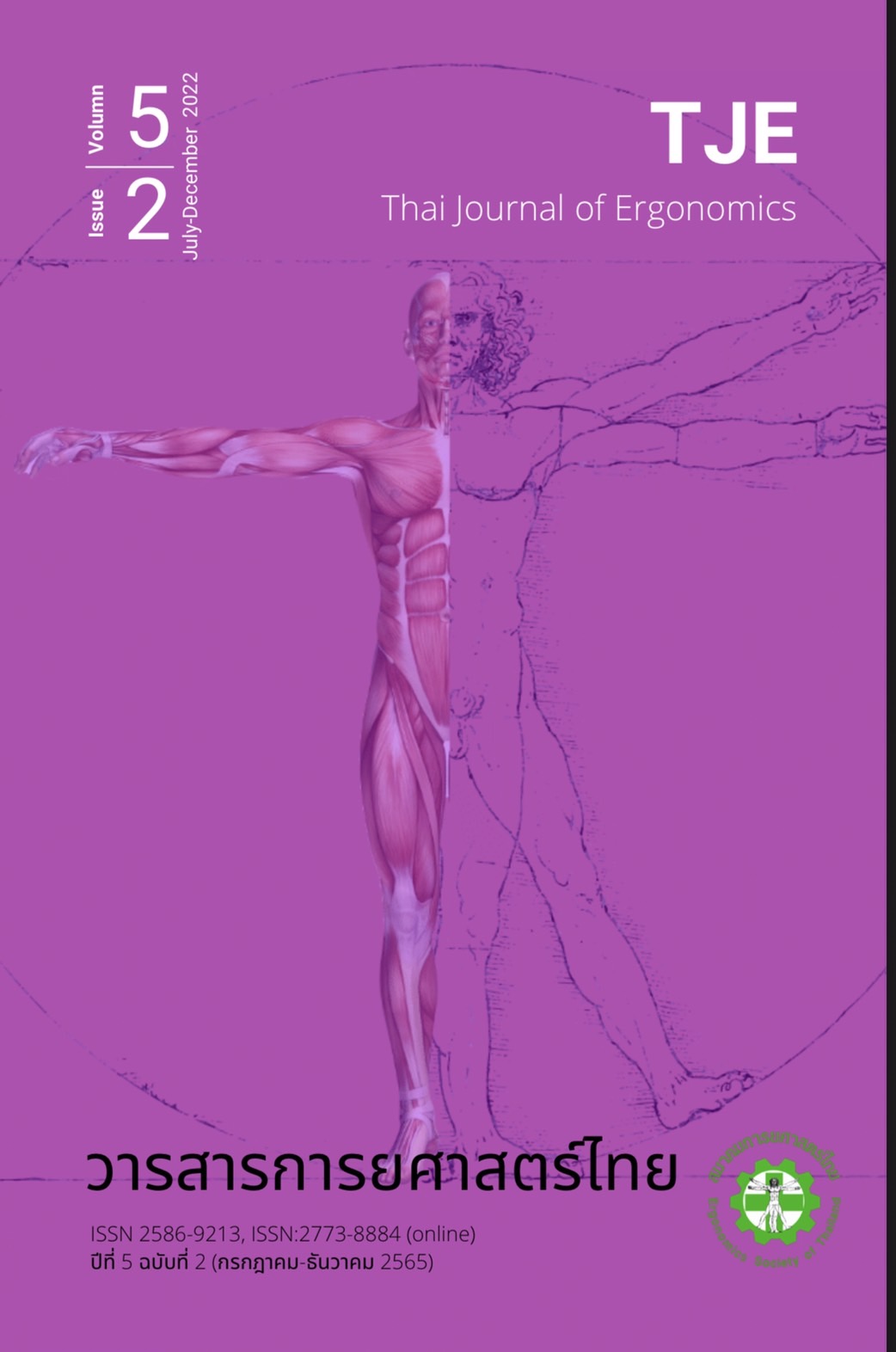Association of ergonomic assessment techniques to assess the risk of upper limb musculoskeletal disorders (LUBA and RULA techniques): A case study of workers' posture in gas lighter assembly
Main Article Content
Abstract
Work-related musculoskeletal disorders are health effects arising from exposure to ergonomic hazards. Selecting an appropriate ergonomic assessment tool can reduce and prevent the risk of injury or illness. This study aims to assess the risk of musculoskeletal disorders and determine the effectiveness of the relationship between LUBA and RULA assessment techniques in predicting upper limb musculoskeletal disorders. The study was conducted on 27 gas lighter assembly enterprise in Chiang Rai. The musculoskeletal disorders were gathered by using standardized Nordic questionnaires, and three different work postures, that are: 1) insert equipment posture, 2) fire inspection posture, and 3) electric screw posture, were assessed for ergonomic risk by using the LUBA and RULA assessment techniques. The results revealed that the right-side shoulder had the highest prevalence of MSDs (50%), followed by the right-side hand/wrist (41.67%). Ergonomic assessment risk showed that the LUBA technique identified a medium and high risk level (42.6%) and the RULA technique identified a medium risk level (100%). The Spearman's correlation revealed a significant difference between LUBA and RULA of electric screw posture at the left side (p<0.05), but there was no significant difference in insert equipment posture at the right side (p=0.243), left side (p=0.131), and fire inspection posture at the right side (p=0.268), left side (p=0.262). Therefore, the selection of ergonomic risk assessment techniques should be considered in accordance with assessment objectives, work characteristics or positions, and the accuracy of the tool in order to get an accurate risk and lead to the correct approach to problem solving.
Article Details

This work is licensed under a Creative Commons Attribution-NonCommercial-NoDerivatives 4.0 International License.
References
อรรถพล แก้วนวล, บรรพต โลหะพูนตระกูล, กลางเดือน โพชนา. ความชุกของความผิดปกติของระบบกล้ามเนื้อและกระดูกโครงร่างที่เกี่ยวเนื่องจากการทำงานในอาชีพต่างๆ. วารสารสาธารณสุขมหาวิทยาลัยบูรพา. 2560;12(2):53-64.
กระทรวงสาธารณสุข. รายงานสถานการณ์โรคและภัยสุขภาพจากการประกอบอาชีพและสิ่งแวดล้อม ปี 2561 [อินเทอร์เน็ต]. นนทบุรี: กองโรคจากการประกอบอาชีพและสิ่งแวดล้อม กรมควบคุมโรค กระทรวงสาธารณสุข; 2562 [เขาถึงเมื่อ 22 พ.ค. 2565]. เข้าถึงได้จาก: http://envocc.ddc.moph.go.th/uploads/situation2/2561/2561_01_envocc_situation.pdf
กตัณชานุช สมนา. ปัจจัยที่เกี่ยวข้องกับอาการผิดปกติในระบบโครงร่างกล้ามเนื้อของเกษตรกรปลูกข้าวโพด ตำบลศรีวิชัย อำเภอลี้ จังหวัดลำพูน [การศึกษาค้นคว้าด้วยตนเองปริญญาสาธารณสุขศาสตรมหาบัณฑิต]. เชียงใหม่: มหาวิทยาลัยเชียงใหม่; 2557.
ประกาศิต ทอนช่วย, เกษแก้ว เสียงเพราะ. ปัจจัยที่มีความสัมพันธ์กับอาการผิดปกติทางระบบโครงร่างและกล้ามเนื้อของเกษตรกรเก็บลิ้นจี่ จังหวัดพะเยา. วารสารสุขศึกษา. 2562;42(1):119-34.
ตะวัน วรรณรัตน์. การศึกษาแรงงานนอกระบบในประเทศไทย. วารสารมหาวิทยาลัยศิลปากร. 2557;34(3): 119-50.
กรมสวัสดิการและคุ้มครองแรงงาน.การสังเคราะห์องค์ความรู้จากงานวิจัยเกี่ยวกับแรงงานนอกระบบเพื่อการบริหารจัดการแรงงานนอกระบบที่ดีอย่างมีประสิทธิภาพ [อินเทอร์เน็ต]. กรุงเทพฯ: กองคุ้มครองแรงงานนอกระบบ กรมสวัสดิการและคุ้มครองแรงงานกระทรวงแรงงาน; 2561 [เขาถึงเมื่อ 22 พ.ค. 2565]. เข้าถึงได้จาก: https://informal.labour.go.th/images/Report/FinalReport01.pdf
วิวัฒน์ สังฆะบุตร, สุนิสา ชายเกลี้ยง. ความผิดปกติทางระบบโครงร่างและกล้ามเนื้อในแรงงานนอกระบบกลุ่มดัดเหล็กปลอกเสาระบบมือโยก: การศึกษานำร่อง. ศรีนครินทร์เวชสาร. 2554;26(3):225-32.
จันจิรา ทิพวัง, กาญจนา นาถะพินธุ. ความชุกและปัจจัยที่มีความสัมพันธ์กับอาการปวดกล้ามเนื้อของกลุ่มอาชีพเย็บผ้าโหล ตำบลน้ำโมง อำเภอท่าบ่อ จังหวัดหนองคาย. วารสารสำนักงานป้องกันควบคุมโรคที่ 7 จังหวัดขอนแก่น. 2559;23(1):46-61.
ชมพูนุช สุภาพวานิช, อาอีเสาะ มูซอ, อัญชลี พงษ์เกษตร. ความชุกของอาการปวดหลังส่วนล่างในแรงงานนอกระบบของท่าเทียบเรือประมงแห่งหนึ่งในจังหวัดปัตตานี. วารสารมหาวิทยาลัยนราธิวาสราชนครินทร์. 2562;11(3):55-68.
ยุพยง หมั่นกิจ, กติกา สระมณีอินทร์. การศึกษาอาการปวดเมื่อยโครงร่างและกล้ามเนื้อของพ่อค้าส่งผลไม้ตลาดเจริญศรี อำเภอวารินชำราบ จังหวัดอุบลราชธานี. วารสารวิทยาศาสตร์และเทคโนโลยี มหาวิทยาลัยอุบลราชธานี. 2561;20(3):180-8.
จุฑามาศ ตามเพิ่ม, อัมรินทร์ คงทวีเลิศ, ดุสิต สุจิรารัตน์, เพชรรัตน์ ภูอนันตานนท์. ความชุกและปัจจัยที่ส่งผลต่ออาการผิดปกติทางระบบกล้ามเนื้อและกระดูกโครงร่างของกล่มช่างทำทองไทยโบราณ จังหวัดสุโขทัย. ศรีนครินทร์เวชสาร. 2562;34(5):475-81.
เพชรรัตน์ แก้วดวงดี, รุ้งทิพย์ พันธุเมธากุล, วัณทนา ศิริธราธิวัตร, ยอดชาย บุญประกอบ, สาวิตรี วันเพ็ญ, ภาณี ฤทธิ์มาก, ยุพา ถาวรพิทักษ์. ความชุกและปัจจัยด้านท่าทางการทำงานที่สัมพันธ์กับอาการปวดหลังส่วนล่างในกลุ่มอาชีพอุตสาหกรรมสิ่งทอ (แหอวน) จังหวัดขอนแก่น. ศรีนครินทร์เวชสาร. 2554;26(4):317-24.
อิสรีย์รัช สืบศรี, มัณฑนา ดำรงศักดิ์, ธีรนุช ห้านิรัติศัย. ปัจจัยที่มีความสัมพันธ์กับการบาดเจ็บโครงร่างกล้ามเนื้อที่เกี่ยวเนื่องจากการทำงานในผู้ประกอบอาชีพผลิตธูป. พยาบาลสาร. 2556;40(พิเศษ):108-19.
ทศพล บุตรมี. เครื่องมือประเมินปัจจัยเสี่ยงด้านการยศาสตร์จากการทำงาน. วารสารควบคุมโรค. 2559;42 (1):11-4.
Yazdanirad S, Khoshakhlagh AH, Habibi E, Zare A, Zeinodini M, Dehghani F. Comparing the effectiveness of three ergonomic risk assessment methods-RULA, LUBA, and NERPA-to predict the upper extremity musculoskeletal disorders. Indian J Occup Environ Med. 2018;22(1):17-21.
Vahdatpour B, Sadeghi S. Postural assessment and the prevalence of musculoskeletal disorders during routine clinical examinations among otolaryngologists in Isfahan City, Iran. J Phys Med Rehabil Elect. 2007;1(4):172–9.
Pratiwi I, Rahman M. Postural evaluation and hand activity level at Batik Cap Process using LUBA and ACGIH HAL methods. Int J Recent Technol Eng. 2019;8:2552-60.
Beheshti MH, Borhani jebeli M, Tajpoor A. Evaluating the potential risk of musculoskeletal disorders and postural loading of task postures in bakery. Arch Occup Health. 2018;2(4):216-24.
Kuorinka I, Jonsson B, Kilbom A, Vinterberg H, Biering-Sørensen F, Andersson G, et al. Standardised Nordic questionnaires for the analysis of musculoskeletal symptoms. Appl Ergon. 1987;18(3):233-7.
McAtamney L, Nigel Corlett E. RULA: a survey method for the investigation of work-related upper limb disorders. Appl Ergon. 1993;24(2):91-9.
Kee D, Karwowski W. LUBA: an assessment technique for postural loading on the upper body based on joint motion discomfort and maximum holding time. Appl Ergon. 2001;32(4):357-66.
Sahu S, Sett M. Ergonomic evaluation of the tasks performed by the female workers in the unorganized sectors of the manual brick manufacturing units in India. Ergonomics SA. 2010;22:2-16.
Sanchez-Lite A, Garcia M, Domingo R, Angel Sebastian M. Novel ergonomic postural assessment method (NERPA) using product-process computer aided engineering for ergonomic workplace design. PloS One. 2013;8(8):e72703.
Chiasson M-È, Imbeau D, Aubry K, Delisle A. Comparing the results of eight methods used to evaluate risk factors associated with musculoskeletal disorders. Int J Ind Ergon. 2012;42(5):478-88.
David GC. Ergonomic methods for assessing exposure to risk factors for work-related musculoskeletal disorders. Occup Med (Lond). 2005;55(3):190-9.
Grooten WJA, Johansson E. Observational methods for assessing ergonomic risks for work related musculoskeletal disorders. a scoping review. Rev Cienc de la Salud. 2018;16:8. doi:10.12804/revistas.urosario.edu.co/revsalud/a.6840.


